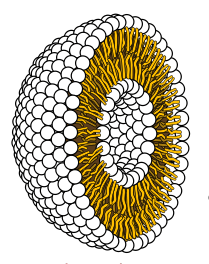
Cross-section through liposome. Water-attracting ends of molecules (white); Water-repellent ends (brown). (Source: Wikimedia Commons, Author Philcha)
Targeting tumors without causing systemic damage is challenging using the chemotherapies available, thus methods to directly target the tumour microenvironment remains a goal for researchers. Recently, researchers in South Korea have identified a new method for treating difficult cancers using state-of-the art liposome technology. The purpose of the study was to demonstrate the utility of thermal induction to destroy cancer cells through a process known as apoptosis or classic programmed cell death in pre-clinical animal models. Thermal-sensitive liposomes are novel technology that allows for release of liposome cargo after heat activation.
Infrared-technology works by releasing cargo for cancer cell death using Poly:IC to elicit TLR receptors activating important dendritic cells by using lasers to increase the temperature of the site of the liposome. By including a dual solution for eliciting antigen presenting cells to mature and naive T cells, through photothermal therapy (PTT) induced tumour cell antigen release and activation using thermal-sensitive liposomes activating dendritic cells via TLR-3, an effective adaptive immune response was mounted through creating an inflammatory environment through TLR activation. Dendritic cells found within the draining lymph node lead to activation of CD8+ T-cells inducing direct cellular cytotoxicity of the tumour. Furthermore, these dendritic cells expressed CD40+ co-stimulatory molecules in greater number than negative controls, this was attributed to poly:IC release from liposomes confirming the success of the technology. The death of cancer cells through apoptosis via PTT, utilizing the TLR 3 activated dendritic cells and preventing a dampening of immune systems by including poly:IC, an efficient adaptive immune responses. These dendritic cells also activated CD4+ T-cells, and induced cancer-specific antibodies. The benefit of using a system of photothermal therapy and temperature-sensitive liposomes versus conventional chemotherapy remains rooted in the non-specific manner of chemotherapy where many general cellular processes are reduced causing massive cell death and often necrosis leading to uncontrollable inflammation.
Limitations of the study include the use of animal model of cancer versus available xenograft models for the type of cancer selected. Furthermore, additional studies are required to determine the appropriate dose for second immune responses against the 2nd transplanted cancer. Though the authors did not compare other chemotherapies to the technology for survival and efficacy, the localized technique and use of a tumour-specific solution could prevent mortality. This study highlights the potential of PTT as an alternative therapy to manipulate the cancer microenvironment, in addition to using chemotherapy.
Journal Article: Xu et al., (2019). Indocyanine green and poly I: C containing thermo-responsive liposomes used in immune-photothermal therapy prevent cancer growth and metastasis. Journal for immunotherapy of cancer
Article by Sohail Mahmood











